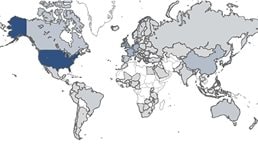After a decade of aftershocks from the seismic financial crisis of 2007, the landscape of global finance is much altered. Global cross-border capital flows—including lending, purchases of equities and bonds, and foreign direct investment—have shrunk by 65 percent since 2007, from $12.4 trillion to $4.3 trillion (Exhibit 1). Half of that decline reflects a sharp reduction in cross-border lending and other banking activities. But it would be wrong to conclude that financial globalization is over. New research from the McKinsey Global Institute, The new dynamics of financial globalization, concludes that what is emerging from the rubble is a more risk-sensitive, rational, and ultimately more resilient version of global financial integration.

Part 1 of this report looks at the shifts in global banking, exploring the dynamics and drivers of bank retrenchment in Europe and the United States and the expansion of foreign activities of banks from other advanced and developing economies. Part 2 assesses the overall state of financial globalization and takes stock of the changing roles of countries in the global financial system. Part 3 provides a forward-looking view on the global financial system, suggesting that it promises more stability, but old and new risks remain. Finally, Part 4 discusses how banks and regulators can respond to the new era of financial globalization and the new digital technologies that may shape cross-border financial connections in the future.

Global banks retrench
The most dramatic change in the postcrisis global financial system has been in cross-border lending. Large European banks—particularly those in the eurozone—are leading the retreat from foreign markets. Foreign claims of eurozone banks (including loans, other foreign assets, and lending by foreign subsidiaries) have declined by $7.3 trillion, or 45 percent, since 2007 (Exhibit 2). Nearly half has occurred in intra-eurozone borrowing, with interbank lending declining the most. The foreign claims of Swiss, UK, and other European banks have fallen by $2.1 trillion. Several of the largest US banks are shifting their portfolios away from foreign business, too.

From January 2007 to December 2016, banks worldwide divested at least $2 trillion of assets (often at the behest of supervisors), more than half of the total by European banks.
Several factors have prompted the retrenchment of European and US banks:
- Losses after the crisis led to a reappraisal of country risk, particularly within the eurozone. Many banks also found that foreign business had been less profitable than domestic business, especially in foreign markets in which they lacked scale and local expertise.
- New international regulations on capital and liquidity (Basel III) have indirectly created disincentives for the added scale and complexity that foreign operations entail.
- In some countries, national policies to support the banking system created incentives for domestic lending after the crisis. The UK’s Funding for Lending Scheme is one example.
Would you like to learn more about the McKinsey Global Institute?
Banks are now proceeding more thoughtfully than they had been pre-crisis as they consider their foreign business and global footprints. They are exiting or reducing operations in countries and markets in which they have low market share and lack unique capabilities. This is an ongoing process.
Some banks from developing and other advanced economies, however—notably Canada, China, and Japan—are expanding abroad. Canadian and Japanese banks have doubled foreign claims since 2007 by $2.3 trillion, bringing the total to $5.3 trillion in 2016 ($1.4 trillion for Canada and $3.9 trillion for Japan). China’s four largest banks have increased foreign lending by more than ten times, from $86 billion in 2007 to $1 trillion in 2016. And China’s foreign bank lending could continue to grow: foreign assets are only 9 percent of total bank assets in China, compared to 20 percent or more for banks in advanced economies. This suggests more scope for Chinese banks to expand globally, if they follow the path of the world’s other large banks.

Financial globalization continues
Despite the retrenchment of global banking, financial globalization continues. The global stock of foreign investment relative to GDP has changed little since 2007, standing at roughly 180 percent of world GDP. In absolute terms, total foreign investments have grown to $132 trillion in 2016, up from $103 trillion in 2007. More than one-quarter of equities around the world are owned by foreign investors, up from 17 percent in 2000. In global bond markets, 31 percent of bonds were owned by a foreign investor in 2016, up from 18 percent in 2000. Foreign lending and other investment is the only component of foreign investment assets and liabilities that has declined since the crisis.
While foreign investment stocks remain highly concentrated among a handful of advanced economies, more countries are participating. MGI’s Financial Connectedness Ranking (see the short version of the ranking in this downloadable poster) shows the total stock of foreign investment assets and liabilities for 100 countries, as well as their composition and growth. Advanced economies and international financial centers are the most highly integrated into the global system. The United States, Luxembourg, the United Kingdom, the Netherlands, and Germany top the ranking.
But developing countries are becoming more connected to global finance. Their share of total foreign investment assets has risen from 8 percent to 14 percent in the past decade. China’s rise in global finance is most notable; it rose from 16th place in 2005 to 8th in 2016. China’s total stock of foreign bank lending, foreign direct investment, and portfolio equity and bond investments reached $3.4 trillion in 2016, exceeding its $3.2 trillion of central bank foreign reserve assets—a notable shift.
Exhibit 3
Click the blue arrows to see foreign assets and liabilities for 40 countries.

A more stable global financial system is emerging, but there are still risks
The new era of financial globalization promises more stability, for several reasons.
- Foreign direct investment (FDI) and equity flows now command a much higher share of gross annual capital flows than before the crisis, from 36 percent before 2007 to 69 percent in 2016. This is good news for stability, since FDI is by far the least volatile type of capital flow and cross-border lending is the most volatile.
- Global current-, financial-, and capital-account imbalances have shrunk, from 2.5 percent of world GDP in 2007 to 1.7 percent in 2016. This reduces one potential spark that could ignite a financial crisis. Even more dramatic has been the decline in the very large US deficit and Chinese surplus. For the first time in a decade, developing countries have become net recipients of foreign capital flows.
- Banks around the world have larger capital and liquidity cushions to offset future losses. Most global banks have also built stronger risk-management capabilities.

How capital moves across the globe
Our interactive data visualization shows the size, growth, and structure of cross-border capital flows and the stock of foreign investment by country.
But potential risks also remain and are worth watching.
- Gross capital flows—particularly foreign lending—remain volatile. Over 60 percent of countries experience a large decline, surge, recovery, or reversal in foreign lending each year, creating volatility in exchange rates and making macroeconomic management more difficult. The median fluctuation for these countries is equivalent to 6.7 percent for developing countries and 10.8 percent for advanced economies.
- Equity-market valuations in some markets have reached new heights, which raises questions about whether a bubble could be emerging.
- With more countries participating in global finance, financial contagion remains a risk—especially for developing countries that lack deep, transparent, and liquid domestic financial markets.

Banks and regulators must respond to the dynamics of cross-border finance
Financial globalization is arguably healthier than it was before the crisis, but banks and regulators must remain vigilant and continue to adapt. In the future digital platforms, blockchain, and machine learning may transform financial markets and create new channels for cross-border capital flows. These technologies are enabling faster, lower-cost, and more efficient international transactions, and will further broaden participation in global finance to more firms, investors, and countries.
Banks and regulators must respond to several aspects of the new era.
- Banks. How long the ongoing retrenchment of European and US global banks persists is uncertain, but it is likely that it will continue—or at least not reverse—for the foreseeable future. Banks must continue to scrutinize their international strategies to ensure healthy long-term performance. This will entail focusing on corporate clients and countries in which they have significant market share, and shifting from subsidiary to branch structures when possible in order to optimize their capital. Banks must harness the new technologies across their global operations to increase efficiency, meet customer expectations, and capture new opportunities. Harnessing advanced analytics and machine learning algorithms to better understand risks in international markets could be a competitive edge.
- Regulators. Given the dynamic changes in the way global finance is conducted, policy makers should continue refining regulation and supervision of financial markets. Regulators must continue to build systemic risk monitoring capabilities and ensure prompt reaction to changing market conditions. New tools for managing volatility in capital flows and in reducing capital- and financial- account imbalances are needed. In the eurozone, further development of the banking union and establishment of a capital markets union is warranted and could help promote a return to growing intraregional investments. Continued innovation in digital technologies requires favorable regulatory climate to allow experimentation, but also could create new market dynamics and risks.


